Strategic Planning for Cross Border and Global Organisations
VerifiedAdded on 2023/01/10
|17
|5930
|91
AI Summary
please see attached
Contribute Materials
Your contribution can guide someone’s learning journey. Share your
documents today.
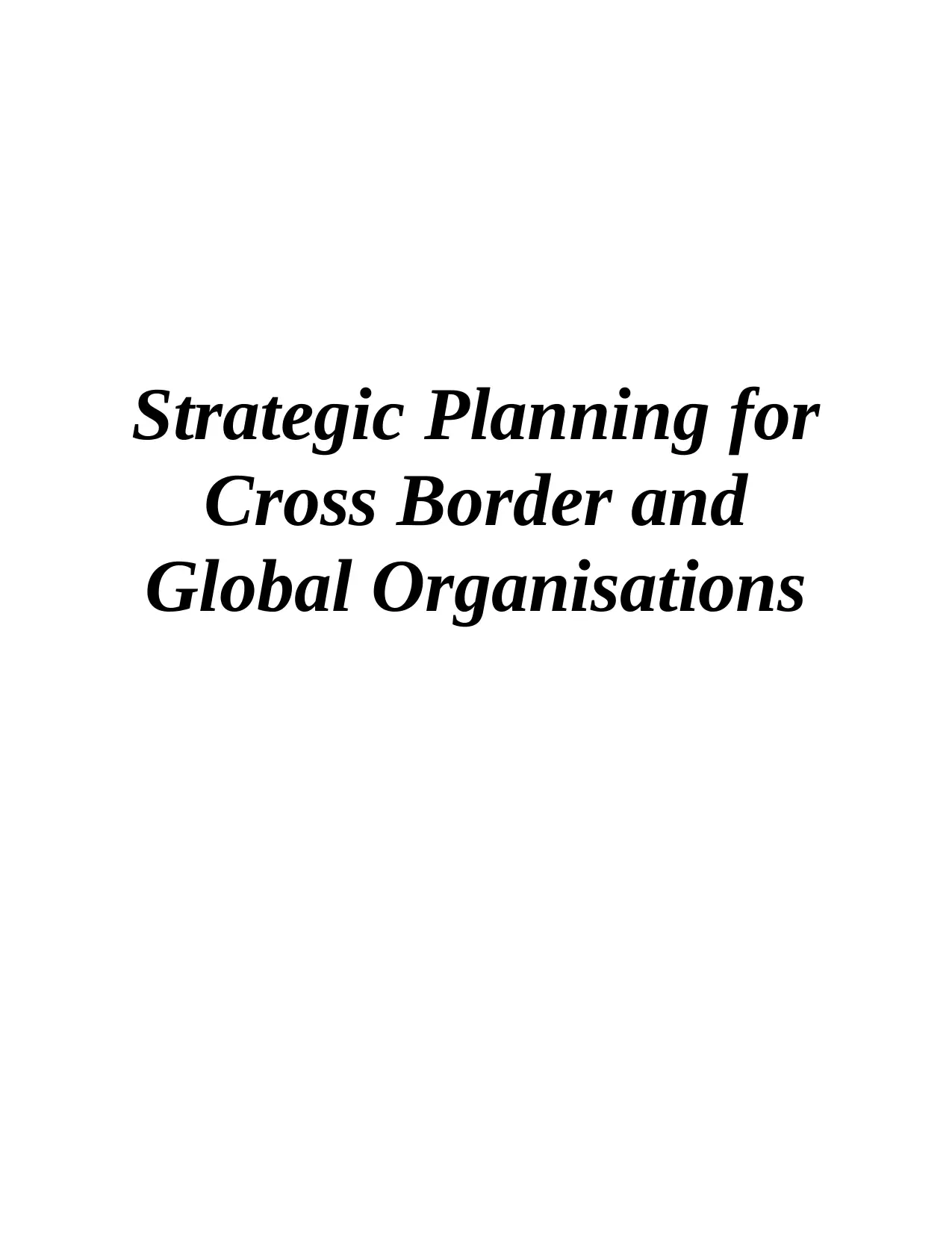
Strategic Planning for
Cross Border and
Global Organisations
Cross Border and
Global Organisations
Secure Best Marks with AI Grader
Need help grading? Try our AI Grader for instant feedback on your assignments.
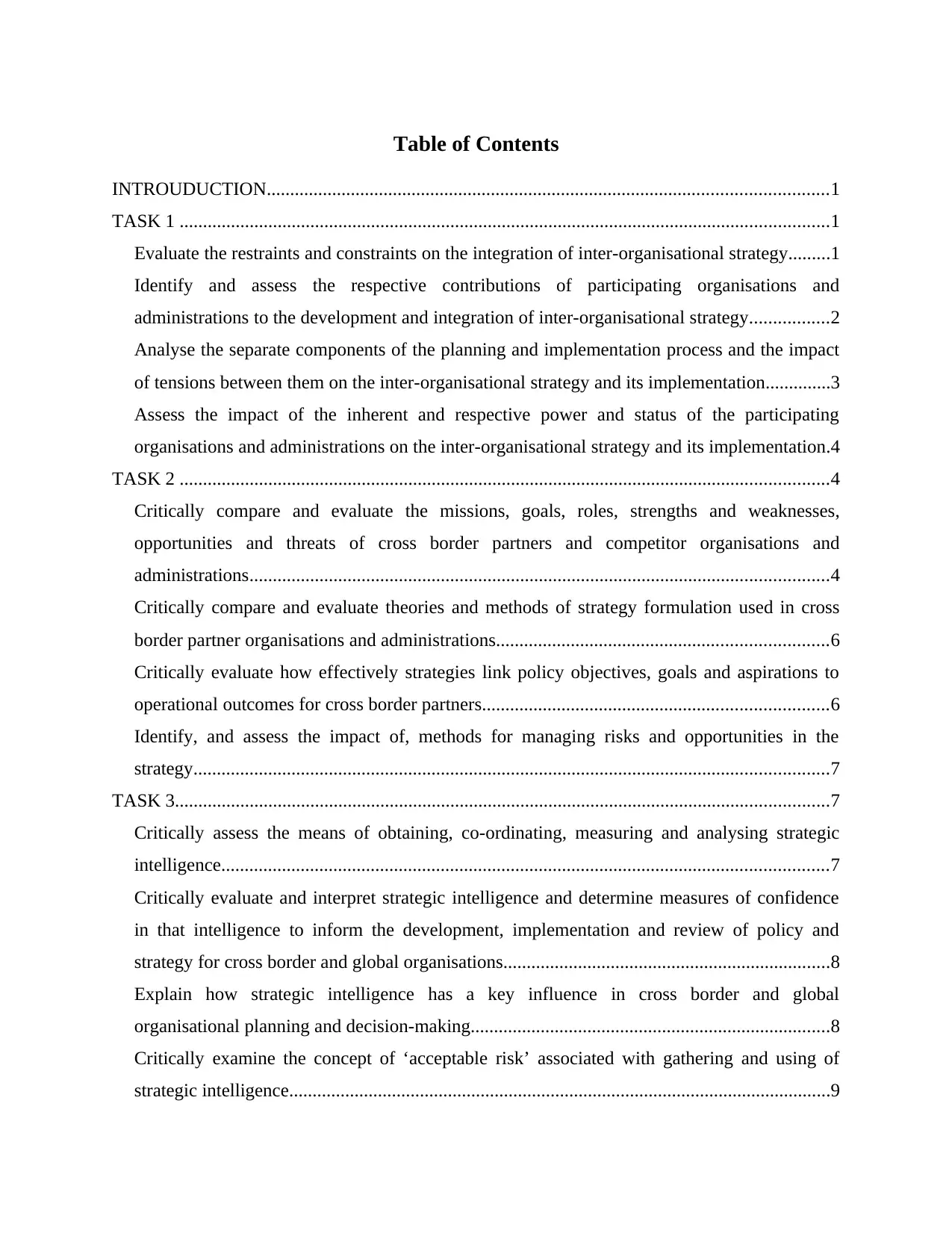
Table of Contents
INTROUDUCTION........................................................................................................................1
TASK 1 ...........................................................................................................................................1
Evaluate the restraints and constraints on the integration of inter-organisational strategy.........1
Identify and assess the respective contributions of participating organisations and
administrations to the development and integration of inter-organisational strategy.................2
Analyse the separate components of the planning and implementation process and the impact
of tensions between them on the inter-organisational strategy and its implementation..............3
Assess the impact of the inherent and respective power and status of the participating
organisations and administrations on the inter-organisational strategy and its implementation.4
TASK 2 ...........................................................................................................................................4
Critically compare and evaluate the missions, goals, roles, strengths and weaknesses,
opportunities and threats of cross border partners and competitor organisations and
administrations............................................................................................................................4
Critically compare and evaluate theories and methods of strategy formulation used in cross
border partner organisations and administrations.......................................................................6
Critically evaluate how effectively strategies link policy objectives, goals and aspirations to
operational outcomes for cross border partners..........................................................................6
Identify, and assess the impact of, methods for managing risks and opportunities in the
strategy........................................................................................................................................7
TASK 3............................................................................................................................................7
Critically assess the means of obtaining, co-ordinating, measuring and analysing strategic
intelligence..................................................................................................................................7
Critically evaluate and interpret strategic intelligence and determine measures of confidence
in that intelligence to inform the development, implementation and review of policy and
strategy for cross border and global organisations......................................................................8
Explain how strategic intelligence has a key influence in cross border and global
organisational planning and decision-making.............................................................................8
Critically examine the concept of ‘acceptable risk’ associated with gathering and using of
strategic intelligence....................................................................................................................9
INTROUDUCTION........................................................................................................................1
TASK 1 ...........................................................................................................................................1
Evaluate the restraints and constraints on the integration of inter-organisational strategy.........1
Identify and assess the respective contributions of participating organisations and
administrations to the development and integration of inter-organisational strategy.................2
Analyse the separate components of the planning and implementation process and the impact
of tensions between them on the inter-organisational strategy and its implementation..............3
Assess the impact of the inherent and respective power and status of the participating
organisations and administrations on the inter-organisational strategy and its implementation.4
TASK 2 ...........................................................................................................................................4
Critically compare and evaluate the missions, goals, roles, strengths and weaknesses,
opportunities and threats of cross border partners and competitor organisations and
administrations............................................................................................................................4
Critically compare and evaluate theories and methods of strategy formulation used in cross
border partner organisations and administrations.......................................................................6
Critically evaluate how effectively strategies link policy objectives, goals and aspirations to
operational outcomes for cross border partners..........................................................................6
Identify, and assess the impact of, methods for managing risks and opportunities in the
strategy........................................................................................................................................7
TASK 3............................................................................................................................................7
Critically assess the means of obtaining, co-ordinating, measuring and analysing strategic
intelligence..................................................................................................................................7
Critically evaluate and interpret strategic intelligence and determine measures of confidence
in that intelligence to inform the development, implementation and review of policy and
strategy for cross border and global organisations......................................................................8
Explain how strategic intelligence has a key influence in cross border and global
organisational planning and decision-making.............................................................................8
Critically examine the concept of ‘acceptable risk’ associated with gathering and using of
strategic intelligence....................................................................................................................9
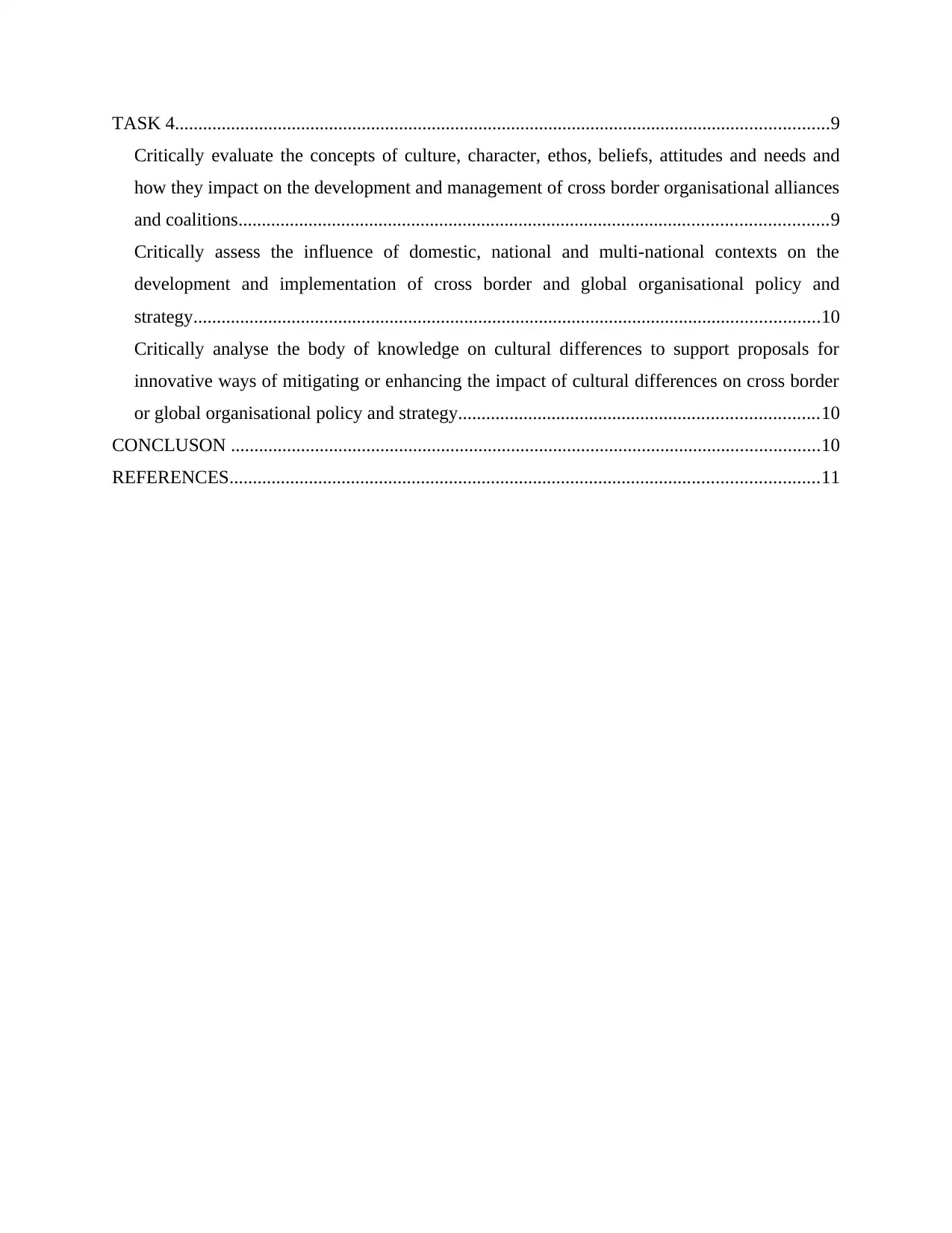
TASK 4............................................................................................................................................9
Critically evaluate the concepts of culture, character, ethos, beliefs, attitudes and needs and
how they impact on the development and management of cross border organisational alliances
and coalitions..............................................................................................................................9
Critically assess the influence of domestic, national and multi-national contexts on the
development and implementation of cross border and global organisational policy and
strategy......................................................................................................................................10
Critically analyse the body of knowledge on cultural differences to support proposals for
innovative ways of mitigating or enhancing the impact of cultural differences on cross border
or global organisational policy and strategy.............................................................................10
CONCLUSON ..............................................................................................................................10
REFERENCES..............................................................................................................................11
Critically evaluate the concepts of culture, character, ethos, beliefs, attitudes and needs and
how they impact on the development and management of cross border organisational alliances
and coalitions..............................................................................................................................9
Critically assess the influence of domestic, national and multi-national contexts on the
development and implementation of cross border and global organisational policy and
strategy......................................................................................................................................10
Critically analyse the body of knowledge on cultural differences to support proposals for
innovative ways of mitigating or enhancing the impact of cultural differences on cross border
or global organisational policy and strategy.............................................................................10
CONCLUSON ..............................................................................................................................10
REFERENCES..............................................................................................................................11
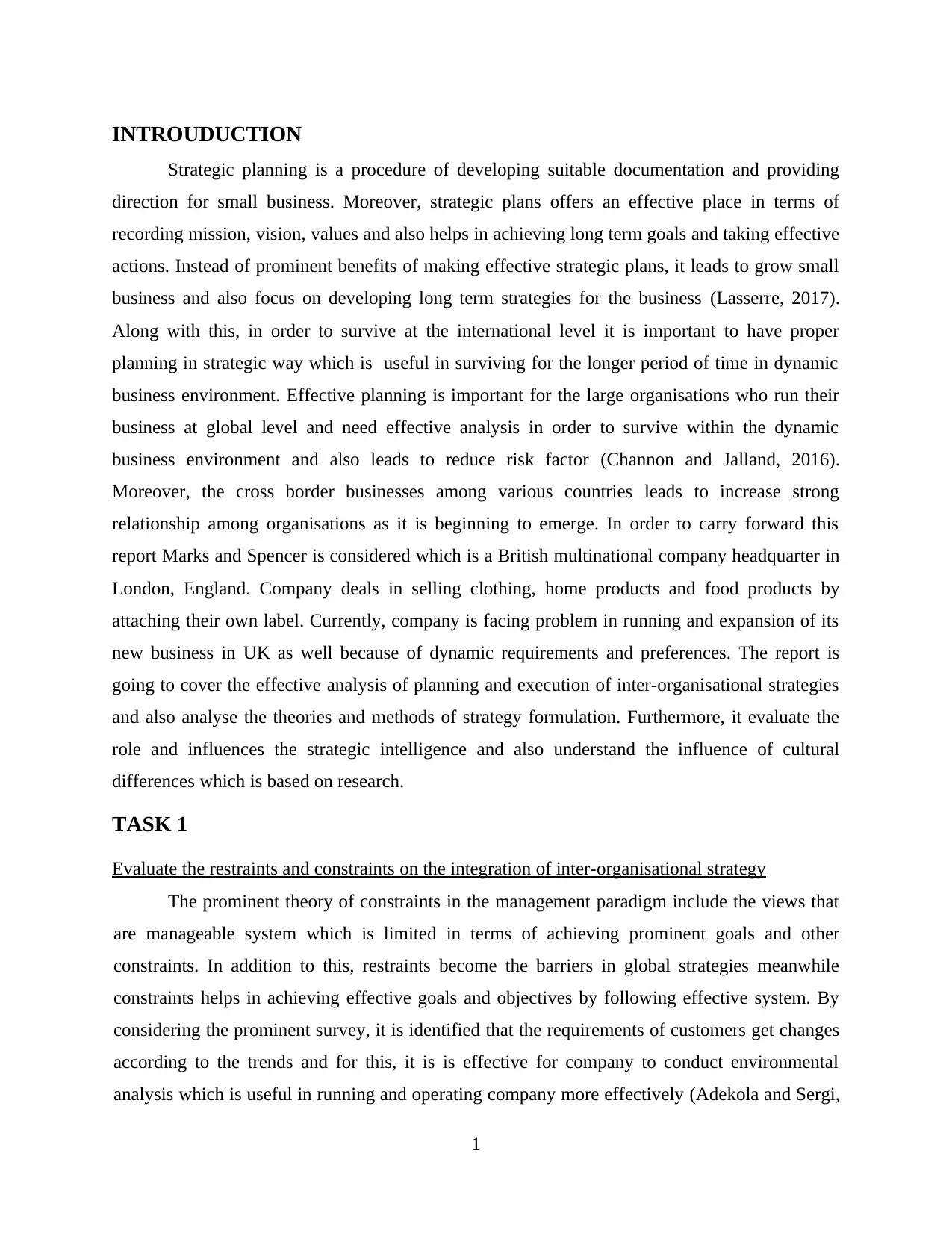
INTROUDUCTION
Strategic planning is a procedure of developing suitable documentation and providing
direction for small business. Moreover, strategic plans offers an effective place in terms of
recording mission, vision, values and also helps in achieving long term goals and taking effective
actions. Instead of prominent benefits of making effective strategic plans, it leads to grow small
business and also focus on developing long term strategies for the business (Lasserre, 2017).
Along with this, in order to survive at the international level it is important to have proper
planning in strategic way which is useful in surviving for the longer period of time in dynamic
business environment. Effective planning is important for the large organisations who run their
business at global level and need effective analysis in order to survive within the dynamic
business environment and also leads to reduce risk factor (Channon and Jalland, 2016).
Moreover, the cross border businesses among various countries leads to increase strong
relationship among organisations as it is beginning to emerge. In order to carry forward this
report Marks and Spencer is considered which is a British multinational company headquarter in
London, England. Company deals in selling clothing, home products and food products by
attaching their own label. Currently, company is facing problem in running and expansion of its
new business in UK as well because of dynamic requirements and preferences. The report is
going to cover the effective analysis of planning and execution of inter-organisational strategies
and also analyse the theories and methods of strategy formulation. Furthermore, it evaluate the
role and influences the strategic intelligence and also understand the influence of cultural
differences which is based on research.
TASK 1
Evaluate the restraints and constraints on the integration of inter-organisational strategy
The prominent theory of constraints in the management paradigm include the views that
are manageable system which is limited in terms of achieving prominent goals and other
constraints. In addition to this, restraints become the barriers in global strategies meanwhile
constraints helps in achieving effective goals and objectives by following effective system. By
considering the prominent survey, it is identified that the requirements of customers get changes
according to the trends and for this, it is is effective for company to conduct environmental
analysis which is useful in running and operating company more effectively (Adekola and Sergi,
1
Strategic planning is a procedure of developing suitable documentation and providing
direction for small business. Moreover, strategic plans offers an effective place in terms of
recording mission, vision, values and also helps in achieving long term goals and taking effective
actions. Instead of prominent benefits of making effective strategic plans, it leads to grow small
business and also focus on developing long term strategies for the business (Lasserre, 2017).
Along with this, in order to survive at the international level it is important to have proper
planning in strategic way which is useful in surviving for the longer period of time in dynamic
business environment. Effective planning is important for the large organisations who run their
business at global level and need effective analysis in order to survive within the dynamic
business environment and also leads to reduce risk factor (Channon and Jalland, 2016).
Moreover, the cross border businesses among various countries leads to increase strong
relationship among organisations as it is beginning to emerge. In order to carry forward this
report Marks and Spencer is considered which is a British multinational company headquarter in
London, England. Company deals in selling clothing, home products and food products by
attaching their own label. Currently, company is facing problem in running and expansion of its
new business in UK as well because of dynamic requirements and preferences. The report is
going to cover the effective analysis of planning and execution of inter-organisational strategies
and also analyse the theories and methods of strategy formulation. Furthermore, it evaluate the
role and influences the strategic intelligence and also understand the influence of cultural
differences which is based on research.
TASK 1
Evaluate the restraints and constraints on the integration of inter-organisational strategy
The prominent theory of constraints in the management paradigm include the views that
are manageable system which is limited in terms of achieving prominent goals and other
constraints. In addition to this, restraints become the barriers in global strategies meanwhile
constraints helps in achieving effective goals and objectives by following effective system. By
considering the prominent survey, it is identified that the requirements of customers get changes
according to the trends and for this, it is is effective for company to conduct environmental
analysis which is useful in running and operating company more effectively (Adekola and Sergi,
1
Secure Best Marks with AI Grader
Need help grading? Try our AI Grader for instant feedback on your assignments.

2016). Furthermore, the political conditions of UK is unstable after the impact of Brexit that can
become restraints in successfully running and functioning of Marks and Spencer in use including
the trade and tariffs and other interest rates. Apart from this, it is also identified that social
factors are also dynamic as the requirements and preferences of people gets fluctuate according
to trend and it is also identified that these components has their own constraints and restraints.
Therefore, few restraints and constraints are evaluated below:
Constraints
Acquisition of additional finances and other resources that are useful in collaborating
with other entities and helps in effective running of company.
Enhanced and developed knowledge and its prominent access for the other components
for smooth expansion.
Enhanced and developed reputation on Marks and Spencer and also have effective impact
on the researchers.
Prominently influenced on the grounds of treatment and other policy. Enhanced access to the subject or data and also leads to develop new methods and
techniques for the better development and expansion (Al-Htaybat and von Alberti-
Alhtaybat, 2018).
Restraints
Global level expansion leads to develop frustration and aggravation in terms of dealing
with other partners and destroy terms among them.
Diversion of time and other resources from other prominent activities.
Insufficient and irrelevant sources in terms of supporting effective collaboration.
At the global level Marks and Spencer can face more difficulty because of geographic
and distance issues that leads to generate its transportation cost.
Because of giving licensing and franchise to other people, owner can lose its control over
the decision and autonomy.
Identify and assess the respective contributions of participating organisations and administrations
to the development and integration of inter-organisational strategy
Strategic management research is significantly related with the understanding of effective
procedure and network governance in terms of developing partnership. In addition to this, inter-
organisational collaboration is complex and dynamic in nature and its implications depends on
2
become restraints in successfully running and functioning of Marks and Spencer in use including
the trade and tariffs and other interest rates. Apart from this, it is also identified that social
factors are also dynamic as the requirements and preferences of people gets fluctuate according
to trend and it is also identified that these components has their own constraints and restraints.
Therefore, few restraints and constraints are evaluated below:
Constraints
Acquisition of additional finances and other resources that are useful in collaborating
with other entities and helps in effective running of company.
Enhanced and developed knowledge and its prominent access for the other components
for smooth expansion.
Enhanced and developed reputation on Marks and Spencer and also have effective impact
on the researchers.
Prominently influenced on the grounds of treatment and other policy. Enhanced access to the subject or data and also leads to develop new methods and
techniques for the better development and expansion (Al-Htaybat and von Alberti-
Alhtaybat, 2018).
Restraints
Global level expansion leads to develop frustration and aggravation in terms of dealing
with other partners and destroy terms among them.
Diversion of time and other resources from other prominent activities.
Insufficient and irrelevant sources in terms of supporting effective collaboration.
At the global level Marks and Spencer can face more difficulty because of geographic
and distance issues that leads to generate its transportation cost.
Because of giving licensing and franchise to other people, owner can lose its control over
the decision and autonomy.
Identify and assess the respective contributions of participating organisations and administrations
to the development and integration of inter-organisational strategy
Strategic management research is significantly related with the understanding of effective
procedure and network governance in terms of developing partnership. In addition to this, inter-
organisational collaboration is complex and dynamic in nature and its implications depends on
2
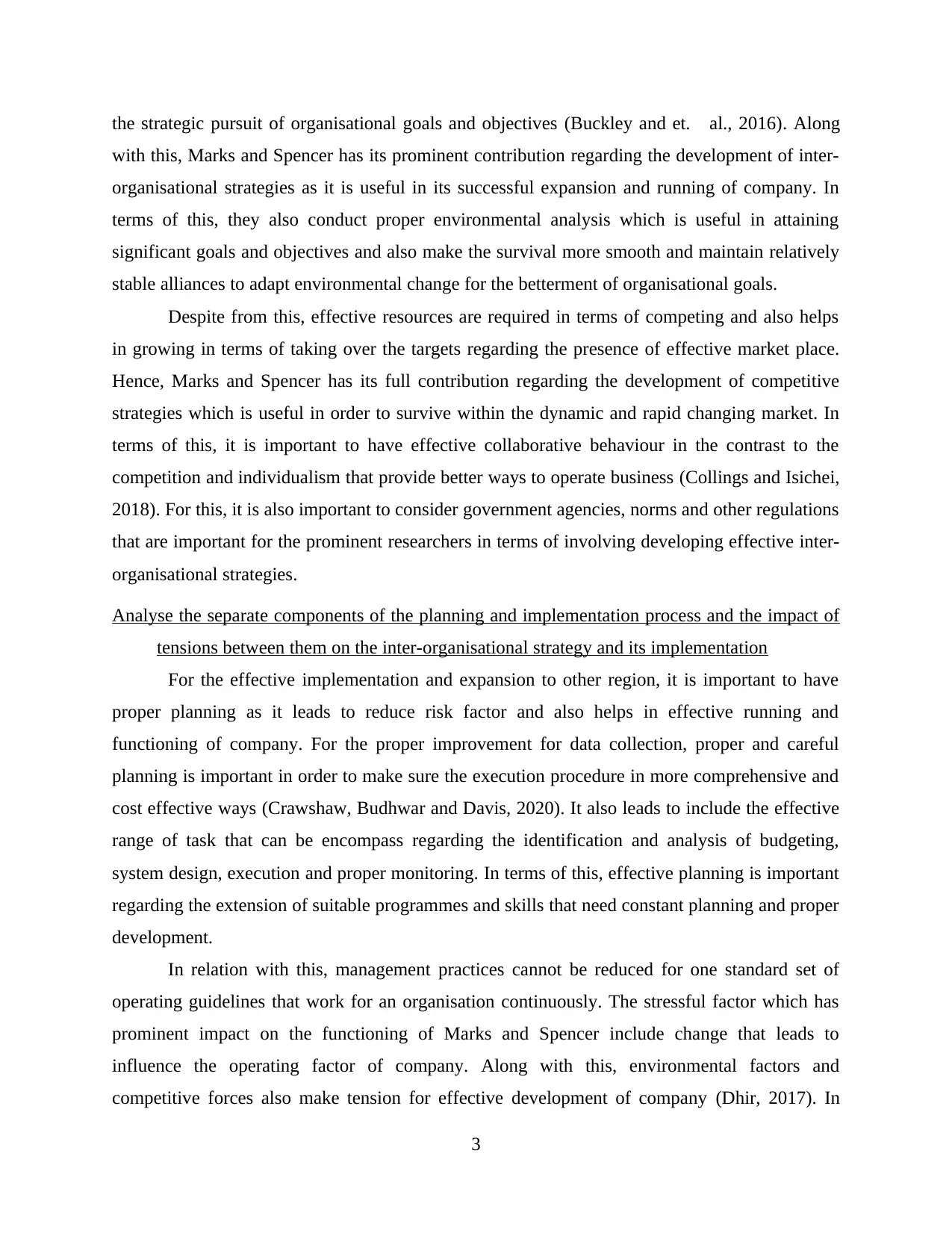
the strategic pursuit of organisational goals and objectives (Buckley and et. al., 2016). Along
with this, Marks and Spencer has its prominent contribution regarding the development of inter-
organisational strategies as it is useful in its successful expansion and running of company. In
terms of this, they also conduct proper environmental analysis which is useful in attaining
significant goals and objectives and also make the survival more smooth and maintain relatively
stable alliances to adapt environmental change for the betterment of organisational goals.
Despite from this, effective resources are required in terms of competing and also helps
in growing in terms of taking over the targets regarding the presence of effective market place.
Hence, Marks and Spencer has its full contribution regarding the development of competitive
strategies which is useful in order to survive within the dynamic and rapid changing market. In
terms of this, it is important to have effective collaborative behaviour in the contrast to the
competition and individualism that provide better ways to operate business (Collings and Isichei,
2018). For this, it is also important to consider government agencies, norms and other regulations
that are important for the prominent researchers in terms of involving developing effective inter-
organisational strategies.
Analyse the separate components of the planning and implementation process and the impact of
tensions between them on the inter-organisational strategy and its implementation
For the effective implementation and expansion to other region, it is important to have
proper planning as it leads to reduce risk factor and also helps in effective running and
functioning of company. For the proper improvement for data collection, proper and careful
planning is important in order to make sure the execution procedure in more comprehensive and
cost effective ways (Crawshaw, Budhwar and Davis, 2020). It also leads to include the effective
range of task that can be encompass regarding the identification and analysis of budgeting,
system design, execution and proper monitoring. In terms of this, effective planning is important
regarding the extension of suitable programmes and skills that need constant planning and proper
development.
In relation with this, management practices cannot be reduced for one standard set of
operating guidelines that work for an organisation continuously. The stressful factor which has
prominent impact on the functioning of Marks and Spencer include change that leads to
influence the operating factor of company. Along with this, environmental factors and
competitive forces also make tension for effective development of company (Dhir, 2017). In
3
with this, Marks and Spencer has its prominent contribution regarding the development of inter-
organisational strategies as it is useful in its successful expansion and running of company. In
terms of this, they also conduct proper environmental analysis which is useful in attaining
significant goals and objectives and also make the survival more smooth and maintain relatively
stable alliances to adapt environmental change for the betterment of organisational goals.
Despite from this, effective resources are required in terms of competing and also helps
in growing in terms of taking over the targets regarding the presence of effective market place.
Hence, Marks and Spencer has its full contribution regarding the development of competitive
strategies which is useful in order to survive within the dynamic and rapid changing market. In
terms of this, it is important to have effective collaborative behaviour in the contrast to the
competition and individualism that provide better ways to operate business (Collings and Isichei,
2018). For this, it is also important to consider government agencies, norms and other regulations
that are important for the prominent researchers in terms of involving developing effective inter-
organisational strategies.
Analyse the separate components of the planning and implementation process and the impact of
tensions between them on the inter-organisational strategy and its implementation
For the effective implementation and expansion to other region, it is important to have
proper planning as it leads to reduce risk factor and also helps in effective running and
functioning of company. For the proper improvement for data collection, proper and careful
planning is important in order to make sure the execution procedure in more comprehensive and
cost effective ways (Crawshaw, Budhwar and Davis, 2020). It also leads to include the effective
range of task that can be encompass regarding the identification and analysis of budgeting,
system design, execution and proper monitoring. In terms of this, effective planning is important
regarding the extension of suitable programmes and skills that need constant planning and proper
development.
In relation with this, management practices cannot be reduced for one standard set of
operating guidelines that work for an organisation continuously. The stressful factor which has
prominent impact on the functioning of Marks and Spencer include change that leads to
influence the operating factor of company. Along with this, environmental factors and
competitive forces also make tension for effective development of company (Dhir, 2017). In
3
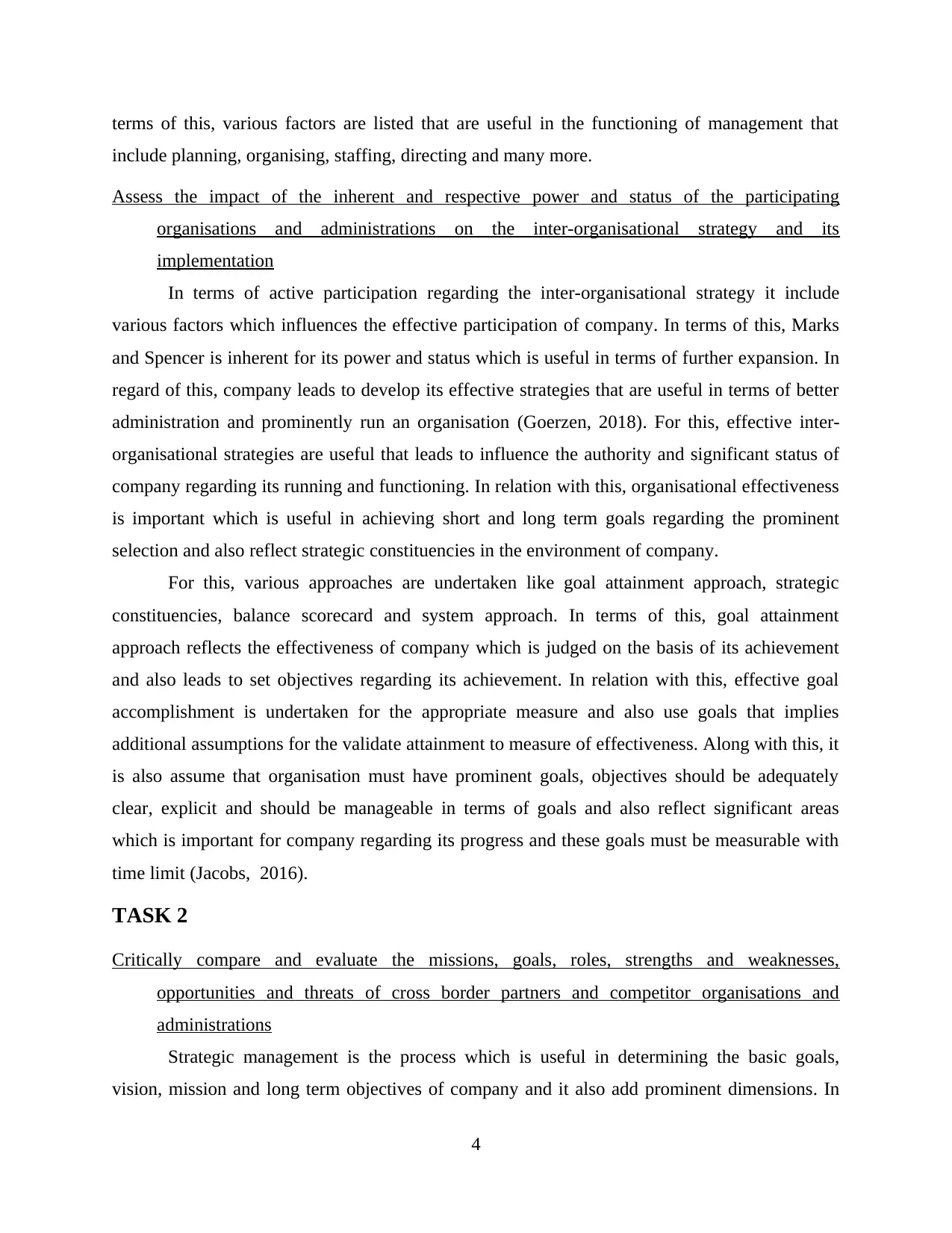
terms of this, various factors are listed that are useful in the functioning of management that
include planning, organising, staffing, directing and many more.
Assess the impact of the inherent and respective power and status of the participating
organisations and administrations on the inter-organisational strategy and its
implementation
In terms of active participation regarding the inter-organisational strategy it include
various factors which influences the effective participation of company. In terms of this, Marks
and Spencer is inherent for its power and status which is useful in terms of further expansion. In
regard of this, company leads to develop its effective strategies that are useful in terms of better
administration and prominently run an organisation (Goerzen, 2018). For this, effective inter-
organisational strategies are useful that leads to influence the authority and significant status of
company regarding its running and functioning. In relation with this, organisational effectiveness
is important which is useful in achieving short and long term goals regarding the prominent
selection and also reflect strategic constituencies in the environment of company.
For this, various approaches are undertaken like goal attainment approach, strategic
constituencies, balance scorecard and system approach. In terms of this, goal attainment
approach reflects the effectiveness of company which is judged on the basis of its achievement
and also leads to set objectives regarding its achievement. In relation with this, effective goal
accomplishment is undertaken for the appropriate measure and also use goals that implies
additional assumptions for the validate attainment to measure of effectiveness. Along with this, it
is also assume that organisation must have prominent goals, objectives should be adequately
clear, explicit and should be manageable in terms of goals and also reflect significant areas
which is important for company regarding its progress and these goals must be measurable with
time limit (Jacobs, 2016).
TASK 2
Critically compare and evaluate the missions, goals, roles, strengths and weaknesses,
opportunities and threats of cross border partners and competitor organisations and
administrations
Strategic management is the process which is useful in determining the basic goals,
vision, mission and long term objectives of company and it also add prominent dimensions. In
4
include planning, organising, staffing, directing and many more.
Assess the impact of the inherent and respective power and status of the participating
organisations and administrations on the inter-organisational strategy and its
implementation
In terms of active participation regarding the inter-organisational strategy it include
various factors which influences the effective participation of company. In terms of this, Marks
and Spencer is inherent for its power and status which is useful in terms of further expansion. In
regard of this, company leads to develop its effective strategies that are useful in terms of better
administration and prominently run an organisation (Goerzen, 2018). For this, effective inter-
organisational strategies are useful that leads to influence the authority and significant status of
company regarding its running and functioning. In relation with this, organisational effectiveness
is important which is useful in achieving short and long term goals regarding the prominent
selection and also reflect strategic constituencies in the environment of company.
For this, various approaches are undertaken like goal attainment approach, strategic
constituencies, balance scorecard and system approach. In terms of this, goal attainment
approach reflects the effectiveness of company which is judged on the basis of its achievement
and also leads to set objectives regarding its achievement. In relation with this, effective goal
accomplishment is undertaken for the appropriate measure and also use goals that implies
additional assumptions for the validate attainment to measure of effectiveness. Along with this, it
is also assume that organisation must have prominent goals, objectives should be adequately
clear, explicit and should be manageable in terms of goals and also reflect significant areas
which is important for company regarding its progress and these goals must be measurable with
time limit (Jacobs, 2016).
TASK 2
Critically compare and evaluate the missions, goals, roles, strengths and weaknesses,
opportunities and threats of cross border partners and competitor organisations and
administrations
Strategic management is the process which is useful in determining the basic goals,
vision, mission and long term objectives of company and it also add prominent dimensions. In
4
Paraphrase This Document
Need a fresh take? Get an instant paraphrase of this document with our AI Paraphraser
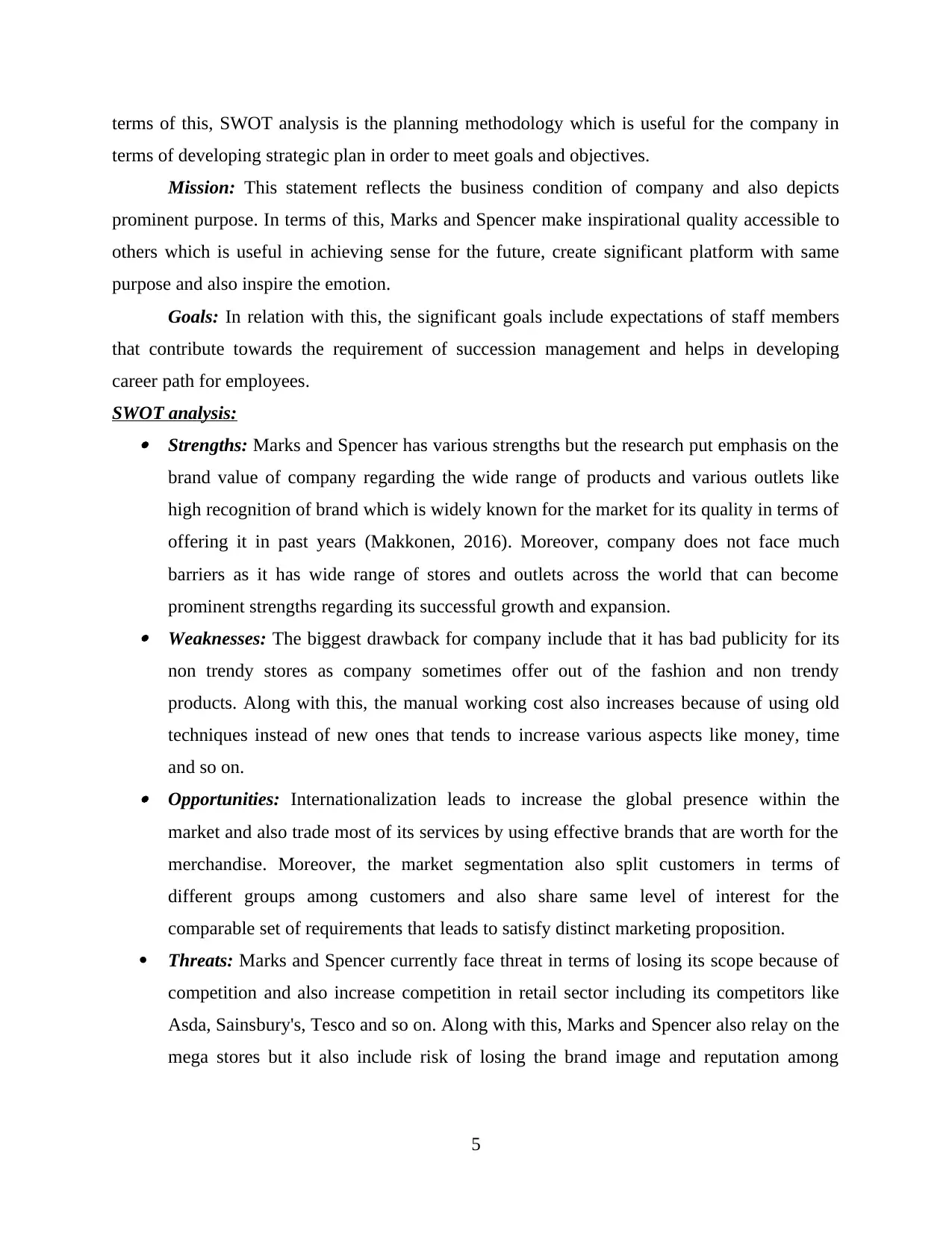
terms of this, SWOT analysis is the planning methodology which is useful for the company in
terms of developing strategic plan in order to meet goals and objectives.
Mission: This statement reflects the business condition of company and also depicts
prominent purpose. In terms of this, Marks and Spencer make inspirational quality accessible to
others which is useful in achieving sense for the future, create significant platform with same
purpose and also inspire the emotion.
Goals: In relation with this, the significant goals include expectations of staff members
that contribute towards the requirement of succession management and helps in developing
career path for employees.
SWOT analysis: Strengths: Marks and Spencer has various strengths but the research put emphasis on the
brand value of company regarding the wide range of products and various outlets like
high recognition of brand which is widely known for the market for its quality in terms of
offering it in past years (Makkonen, 2016). Moreover, company does not face much
barriers as it has wide range of stores and outlets across the world that can become
prominent strengths regarding its successful growth and expansion. Weaknesses: The biggest drawback for company include that it has bad publicity for its
non trendy stores as company sometimes offer out of the fashion and non trendy
products. Along with this, the manual working cost also increases because of using old
techniques instead of new ones that tends to increase various aspects like money, time
and so on. Opportunities: Internationalization leads to increase the global presence within the
market and also trade most of its services by using effective brands that are worth for the
merchandise. Moreover, the market segmentation also split customers in terms of
different groups among customers and also share same level of interest for the
comparable set of requirements that leads to satisfy distinct marketing proposition.
Threats: Marks and Spencer currently face threat in terms of losing its scope because of
competition and also increase competition in retail sector including its competitors like
Asda, Sainsbury's, Tesco and so on. Along with this, Marks and Spencer also relay on the
mega stores but it also include risk of losing the brand image and reputation among
5
terms of developing strategic plan in order to meet goals and objectives.
Mission: This statement reflects the business condition of company and also depicts
prominent purpose. In terms of this, Marks and Spencer make inspirational quality accessible to
others which is useful in achieving sense for the future, create significant platform with same
purpose and also inspire the emotion.
Goals: In relation with this, the significant goals include expectations of staff members
that contribute towards the requirement of succession management and helps in developing
career path for employees.
SWOT analysis: Strengths: Marks and Spencer has various strengths but the research put emphasis on the
brand value of company regarding the wide range of products and various outlets like
high recognition of brand which is widely known for the market for its quality in terms of
offering it in past years (Makkonen, 2016). Moreover, company does not face much
barriers as it has wide range of stores and outlets across the world that can become
prominent strengths regarding its successful growth and expansion. Weaknesses: The biggest drawback for company include that it has bad publicity for its
non trendy stores as company sometimes offer out of the fashion and non trendy
products. Along with this, the manual working cost also increases because of using old
techniques instead of new ones that tends to increase various aspects like money, time
and so on. Opportunities: Internationalization leads to increase the global presence within the
market and also trade most of its services by using effective brands that are worth for the
merchandise. Moreover, the market segmentation also split customers in terms of
different groups among customers and also share same level of interest for the
comparable set of requirements that leads to satisfy distinct marketing proposition.
Threats: Marks and Spencer currently face threat in terms of losing its scope because of
competition and also increase competition in retail sector including its competitors like
Asda, Sainsbury's, Tesco and so on. Along with this, Marks and Spencer also relay on the
mega stores but it also include risk of losing the brand image and reputation among
5
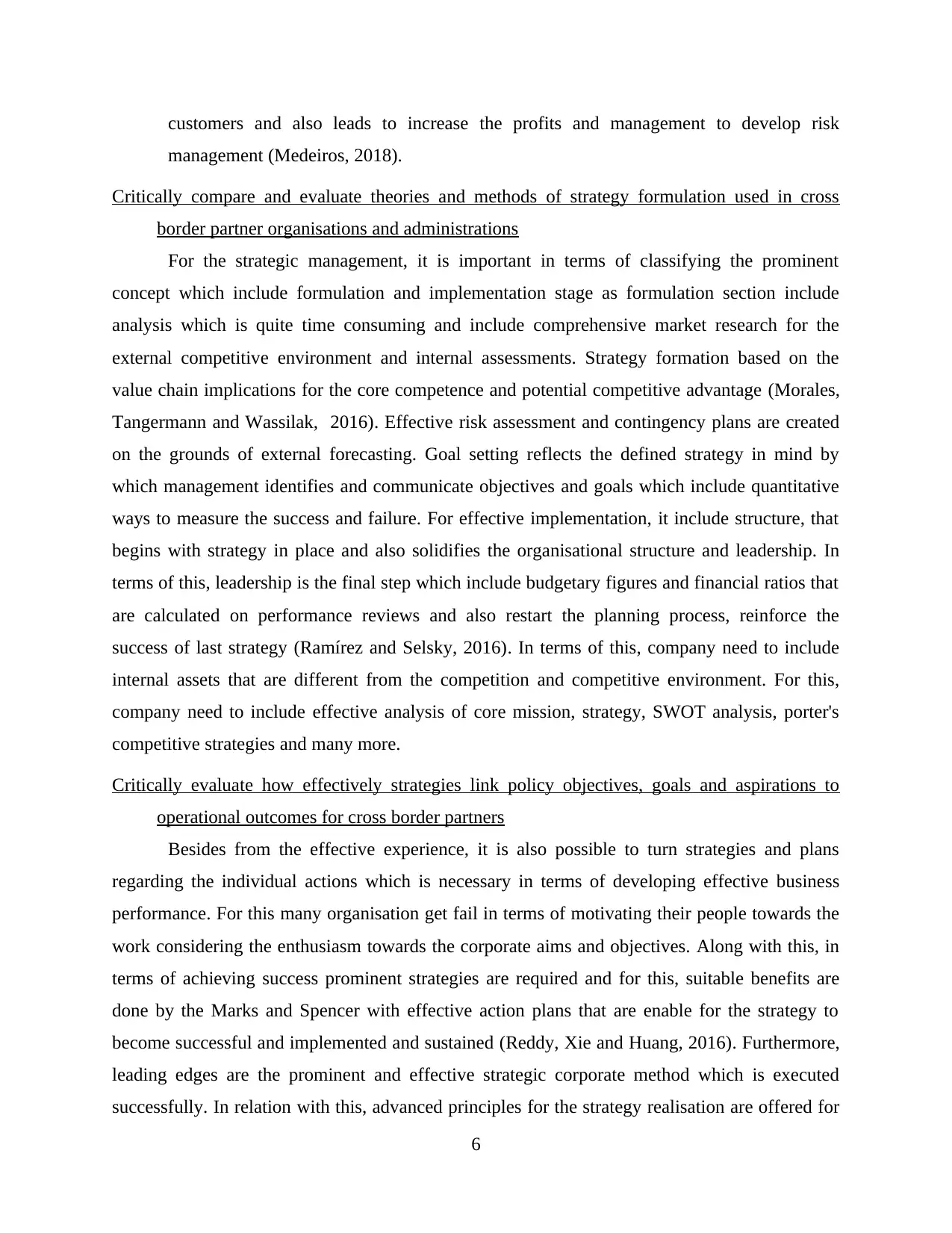
customers and also leads to increase the profits and management to develop risk
management (Medeiros, 2018).
Critically compare and evaluate theories and methods of strategy formulation used in cross
border partner organisations and administrations
For the strategic management, it is important in terms of classifying the prominent
concept which include formulation and implementation stage as formulation section include
analysis which is quite time consuming and include comprehensive market research for the
external competitive environment and internal assessments. Strategy formation based on the
value chain implications for the core competence and potential competitive advantage (Morales,
Tangermann and Wassilak, 2016). Effective risk assessment and contingency plans are created
on the grounds of external forecasting. Goal setting reflects the defined strategy in mind by
which management identifies and communicate objectives and goals which include quantitative
ways to measure the success and failure. For effective implementation, it include structure, that
begins with strategy in place and also solidifies the organisational structure and leadership. In
terms of this, leadership is the final step which include budgetary figures and financial ratios that
are calculated on performance reviews and also restart the planning process, reinforce the
success of last strategy (Ramírez and Selsky, 2016). In terms of this, company need to include
internal assets that are different from the competition and competitive environment. For this,
company need to include effective analysis of core mission, strategy, SWOT analysis, porter's
competitive strategies and many more.
Critically evaluate how effectively strategies link policy objectives, goals and aspirations to
operational outcomes for cross border partners
Besides from the effective experience, it is also possible to turn strategies and plans
regarding the individual actions which is necessary in terms of developing effective business
performance. For this many organisation get fail in terms of motivating their people towards the
work considering the enthusiasm towards the corporate aims and objectives. Along with this, in
terms of achieving success prominent strategies are required and for this, suitable benefits are
done by the Marks and Spencer with effective action plans that are enable for the strategy to
become successful and implemented and sustained (Reddy, Xie and Huang, 2016). Furthermore,
leading edges are the prominent and effective strategic corporate method which is executed
successfully. In relation with this, advanced principles for the strategy realisation are offered for
6
management (Medeiros, 2018).
Critically compare and evaluate theories and methods of strategy formulation used in cross
border partner organisations and administrations
For the strategic management, it is important in terms of classifying the prominent
concept which include formulation and implementation stage as formulation section include
analysis which is quite time consuming and include comprehensive market research for the
external competitive environment and internal assessments. Strategy formation based on the
value chain implications for the core competence and potential competitive advantage (Morales,
Tangermann and Wassilak, 2016). Effective risk assessment and contingency plans are created
on the grounds of external forecasting. Goal setting reflects the defined strategy in mind by
which management identifies and communicate objectives and goals which include quantitative
ways to measure the success and failure. For effective implementation, it include structure, that
begins with strategy in place and also solidifies the organisational structure and leadership. In
terms of this, leadership is the final step which include budgetary figures and financial ratios that
are calculated on performance reviews and also restart the planning process, reinforce the
success of last strategy (Ramírez and Selsky, 2016). In terms of this, company need to include
internal assets that are different from the competition and competitive environment. For this,
company need to include effective analysis of core mission, strategy, SWOT analysis, porter's
competitive strategies and many more.
Critically evaluate how effectively strategies link policy objectives, goals and aspirations to
operational outcomes for cross border partners
Besides from the effective experience, it is also possible to turn strategies and plans
regarding the individual actions which is necessary in terms of developing effective business
performance. For this many organisation get fail in terms of motivating their people towards the
work considering the enthusiasm towards the corporate aims and objectives. Along with this, in
terms of achieving success prominent strategies are required and for this, suitable benefits are
done by the Marks and Spencer with effective action plans that are enable for the strategy to
become successful and implemented and sustained (Reddy, Xie and Huang, 2016). Furthermore,
leading edges are the prominent and effective strategic corporate method which is executed
successfully. In relation with this, advanced principles for the strategy realisation are offered for
6
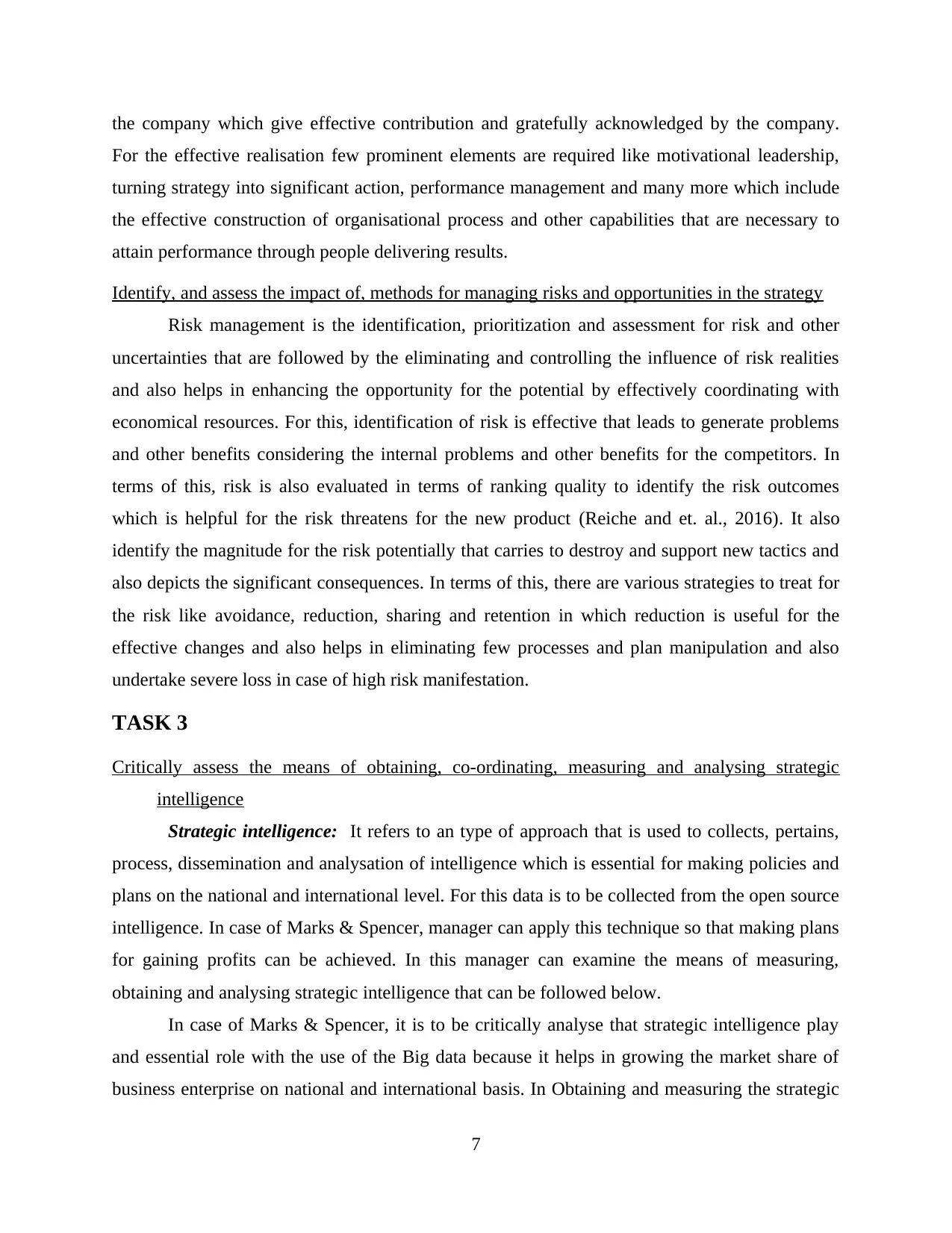
the company which give effective contribution and gratefully acknowledged by the company.
For the effective realisation few prominent elements are required like motivational leadership,
turning strategy into significant action, performance management and many more which include
the effective construction of organisational process and other capabilities that are necessary to
attain performance through people delivering results.
Identify, and assess the impact of, methods for managing risks and opportunities in the strategy
Risk management is the identification, prioritization and assessment for risk and other
uncertainties that are followed by the eliminating and controlling the influence of risk realities
and also helps in enhancing the opportunity for the potential by effectively coordinating with
economical resources. For this, identification of risk is effective that leads to generate problems
and other benefits considering the internal problems and other benefits for the competitors. In
terms of this, risk is also evaluated in terms of ranking quality to identify the risk outcomes
which is helpful for the risk threatens for the new product (Reiche and et. al., 2016). It also
identify the magnitude for the risk potentially that carries to destroy and support new tactics and
also depicts the significant consequences. In terms of this, there are various strategies to treat for
the risk like avoidance, reduction, sharing and retention in which reduction is useful for the
effective changes and also helps in eliminating few processes and plan manipulation and also
undertake severe loss in case of high risk manifestation.
TASK 3
Critically assess the means of obtaining, co-ordinating, measuring and analysing strategic
intelligence
Strategic intelligence: It refers to an type of approach that is used to collects, pertains,
process, dissemination and analysation of intelligence which is essential for making policies and
plans on the national and international level. For this data is to be collected from the open source
intelligence. In case of Marks & Spencer, manager can apply this technique so that making plans
for gaining profits can be achieved. In this manager can examine the means of measuring,
obtaining and analysing strategic intelligence that can be followed below.
In case of Marks & Spencer, it is to be critically analyse that strategic intelligence play
and essential role with the use of the Big data because it helps in growing the market share of
business enterprise on national and international basis. In Obtaining and measuring the strategic
7
For the effective realisation few prominent elements are required like motivational leadership,
turning strategy into significant action, performance management and many more which include
the effective construction of organisational process and other capabilities that are necessary to
attain performance through people delivering results.
Identify, and assess the impact of, methods for managing risks and opportunities in the strategy
Risk management is the identification, prioritization and assessment for risk and other
uncertainties that are followed by the eliminating and controlling the influence of risk realities
and also helps in enhancing the opportunity for the potential by effectively coordinating with
economical resources. For this, identification of risk is effective that leads to generate problems
and other benefits considering the internal problems and other benefits for the competitors. In
terms of this, risk is also evaluated in terms of ranking quality to identify the risk outcomes
which is helpful for the risk threatens for the new product (Reiche and et. al., 2016). It also
identify the magnitude for the risk potentially that carries to destroy and support new tactics and
also depicts the significant consequences. In terms of this, there are various strategies to treat for
the risk like avoidance, reduction, sharing and retention in which reduction is useful for the
effective changes and also helps in eliminating few processes and plan manipulation and also
undertake severe loss in case of high risk manifestation.
TASK 3
Critically assess the means of obtaining, co-ordinating, measuring and analysing strategic
intelligence
Strategic intelligence: It refers to an type of approach that is used to collects, pertains,
process, dissemination and analysation of intelligence which is essential for making policies and
plans on the national and international level. For this data is to be collected from the open source
intelligence. In case of Marks & Spencer, manager can apply this technique so that making plans
for gaining profits can be achieved. In this manager can examine the means of measuring,
obtaining and analysing strategic intelligence that can be followed below.
In case of Marks & Spencer, it is to be critically analyse that strategic intelligence play
and essential role with the use of the Big data because it helps in growing the market share of
business enterprise on national and international basis. In Obtaining and measuring the strategic
7
Secure Best Marks with AI Grader
Need help grading? Try our AI Grader for instant feedback on your assignments.
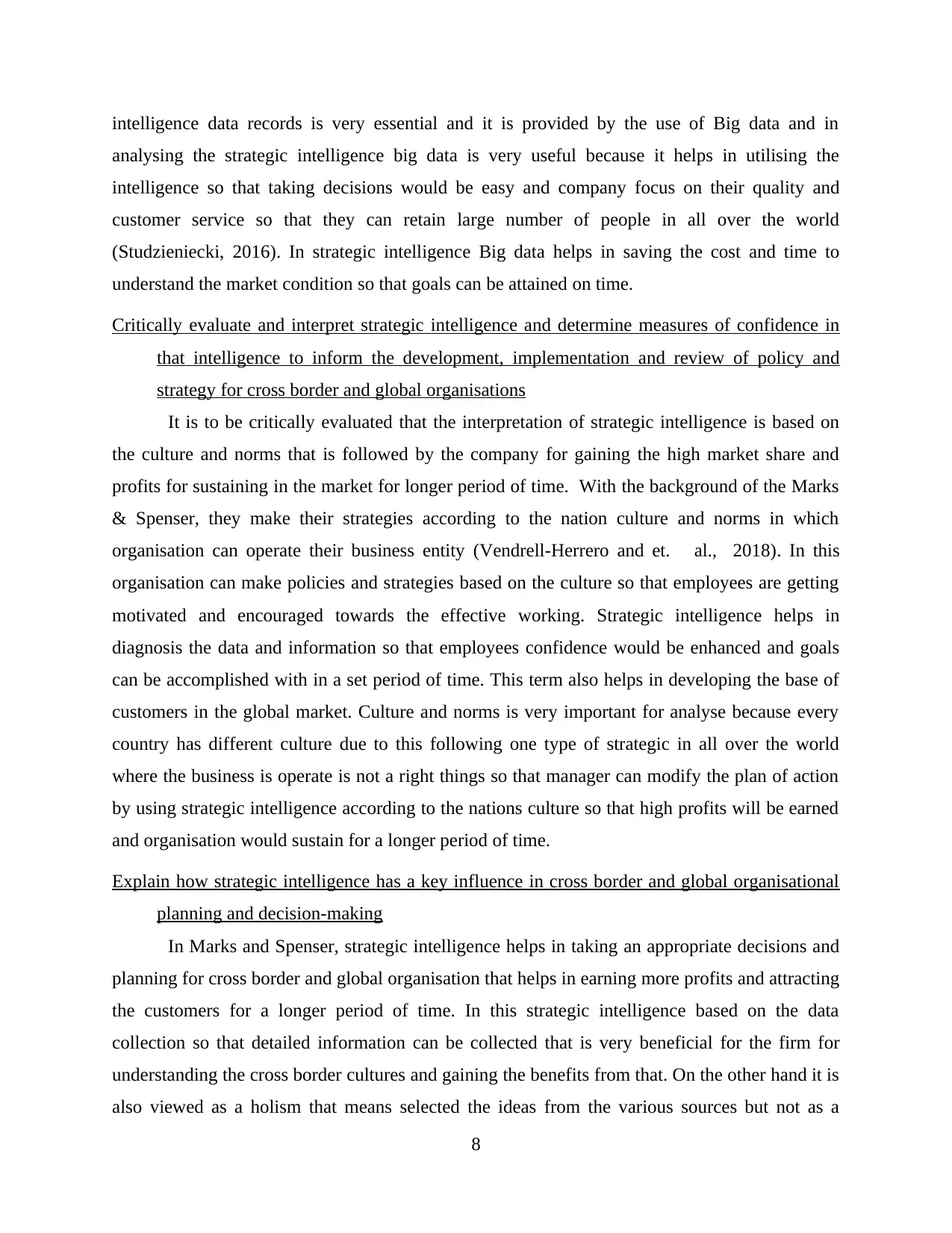
intelligence data records is very essential and it is provided by the use of Big data and in
analysing the strategic intelligence big data is very useful because it helps in utilising the
intelligence so that taking decisions would be easy and company focus on their quality and
customer service so that they can retain large number of people in all over the world
(Studzieniecki, 2016). In strategic intelligence Big data helps in saving the cost and time to
understand the market condition so that goals can be attained on time.
Critically evaluate and interpret strategic intelligence and determine measures of confidence in
that intelligence to inform the development, implementation and review of policy and
strategy for cross border and global organisations
It is to be critically evaluated that the interpretation of strategic intelligence is based on
the culture and norms that is followed by the company for gaining the high market share and
profits for sustaining in the market for longer period of time. With the background of the Marks
& Spenser, they make their strategies according to the nation culture and norms in which
organisation can operate their business entity (Vendrell-Herrero and et. al., 2018). In this
organisation can make policies and strategies based on the culture so that employees are getting
motivated and encouraged towards the effective working. Strategic intelligence helps in
diagnosis the data and information so that employees confidence would be enhanced and goals
can be accomplished with in a set period of time. This term also helps in developing the base of
customers in the global market. Culture and norms is very important for analyse because every
country has different culture due to this following one type of strategic in all over the world
where the business is operate is not a right things so that manager can modify the plan of action
by using strategic intelligence according to the nations culture so that high profits will be earned
and organisation would sustain for a longer period of time.
Explain how strategic intelligence has a key influence in cross border and global organisational
planning and decision-making
In Marks and Spenser, strategic intelligence helps in taking an appropriate decisions and
planning for cross border and global organisation that helps in earning more profits and attracting
the customers for a longer period of time. In this strategic intelligence based on the data
collection so that detailed information can be collected that is very beneficial for the firm for
understanding the cross border cultures and gaining the benefits from that. On the other hand it is
also viewed as a holism that means selected the ideas from the various sources but not as a
8
analysing the strategic intelligence big data is very useful because it helps in utilising the
intelligence so that taking decisions would be easy and company focus on their quality and
customer service so that they can retain large number of people in all over the world
(Studzieniecki, 2016). In strategic intelligence Big data helps in saving the cost and time to
understand the market condition so that goals can be attained on time.
Critically evaluate and interpret strategic intelligence and determine measures of confidence in
that intelligence to inform the development, implementation and review of policy and
strategy for cross border and global organisations
It is to be critically evaluated that the interpretation of strategic intelligence is based on
the culture and norms that is followed by the company for gaining the high market share and
profits for sustaining in the market for longer period of time. With the background of the Marks
& Spenser, they make their strategies according to the nation culture and norms in which
organisation can operate their business entity (Vendrell-Herrero and et. al., 2018). In this
organisation can make policies and strategies based on the culture so that employees are getting
motivated and encouraged towards the effective working. Strategic intelligence helps in
diagnosis the data and information so that employees confidence would be enhanced and goals
can be accomplished with in a set period of time. This term also helps in developing the base of
customers in the global market. Culture and norms is very important for analyse because every
country has different culture due to this following one type of strategic in all over the world
where the business is operate is not a right things so that manager can modify the plan of action
by using strategic intelligence according to the nations culture so that high profits will be earned
and organisation would sustain for a longer period of time.
Explain how strategic intelligence has a key influence in cross border and global organisational
planning and decision-making
In Marks and Spenser, strategic intelligence helps in taking an appropriate decisions and
planning for cross border and global organisation that helps in earning more profits and attracting
the customers for a longer period of time. In this strategic intelligence based on the data
collection so that detailed information can be collected that is very beneficial for the firm for
understanding the cross border cultures and gaining the benefits from that. On the other hand it is
also viewed as a holism that means selected the ideas from the various sources but not as a
8
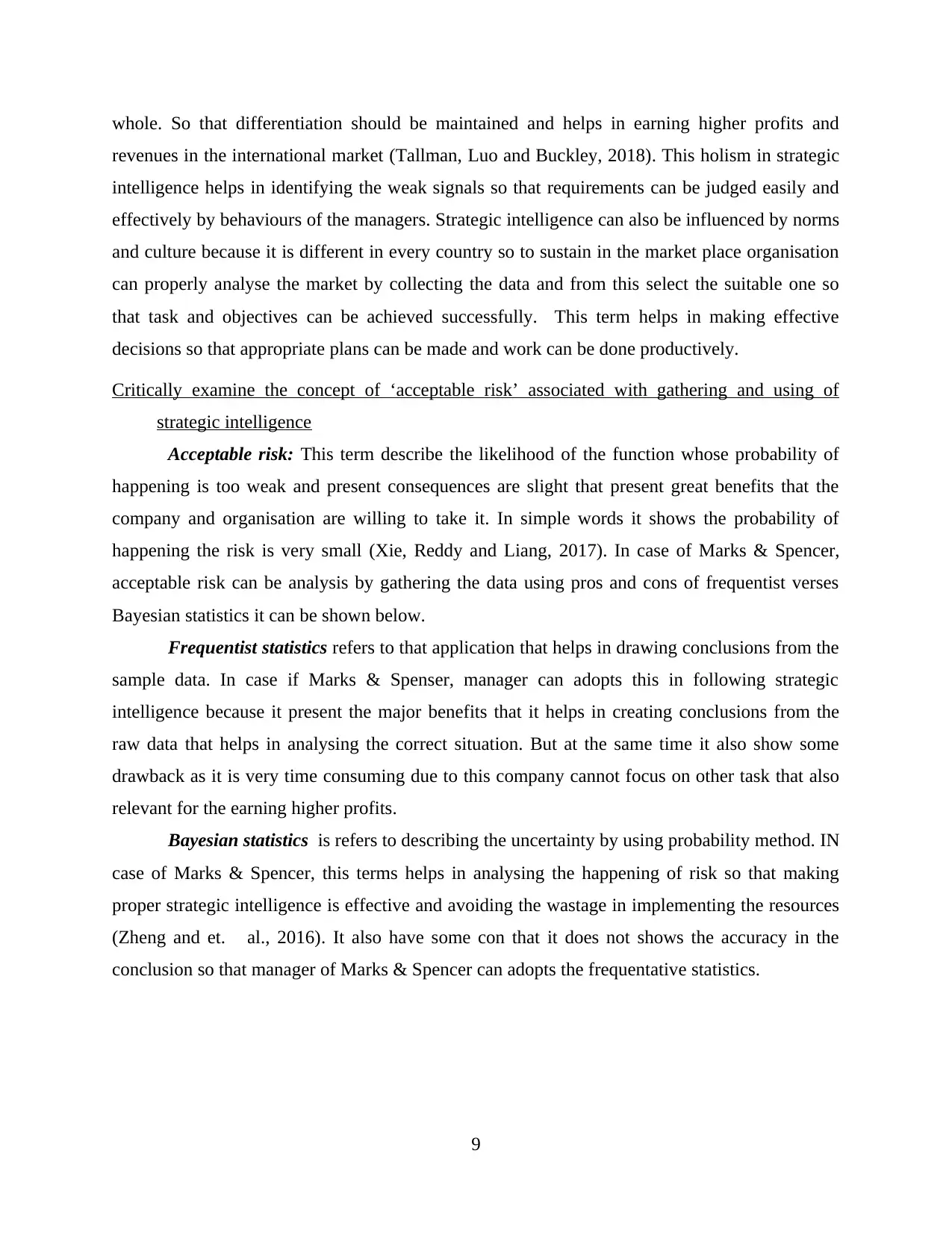
whole. So that differentiation should be maintained and helps in earning higher profits and
revenues in the international market (Tallman, Luo and Buckley, 2018). This holism in strategic
intelligence helps in identifying the weak signals so that requirements can be judged easily and
effectively by behaviours of the managers. Strategic intelligence can also be influenced by norms
and culture because it is different in every country so to sustain in the market place organisation
can properly analyse the market by collecting the data and from this select the suitable one so
that task and objectives can be achieved successfully. This term helps in making effective
decisions so that appropriate plans can be made and work can be done productively.
Critically examine the concept of ‘acceptable risk’ associated with gathering and using of
strategic intelligence
Acceptable risk: This term describe the likelihood of the function whose probability of
happening is too weak and present consequences are slight that present great benefits that the
company and organisation are willing to take it. In simple words it shows the probability of
happening the risk is very small (Xie, Reddy and Liang, 2017). In case of Marks & Spencer,
acceptable risk can be analysis by gathering the data using pros and cons of frequentist verses
Bayesian statistics it can be shown below.
Frequentist statistics refers to that application that helps in drawing conclusions from the
sample data. In case if Marks & Spenser, manager can adopts this in following strategic
intelligence because it present the major benefits that it helps in creating conclusions from the
raw data that helps in analysing the correct situation. But at the same time it also show some
drawback as it is very time consuming due to this company cannot focus on other task that also
relevant for the earning higher profits.
Bayesian statistics is refers to describing the uncertainty by using probability method. IN
case of Marks & Spencer, this terms helps in analysing the happening of risk so that making
proper strategic intelligence is effective and avoiding the wastage in implementing the resources
(Zheng and et. al., 2016). It also have some con that it does not shows the accuracy in the
conclusion so that manager of Marks & Spencer can adopts the frequentative statistics.
9
revenues in the international market (Tallman, Luo and Buckley, 2018). This holism in strategic
intelligence helps in identifying the weak signals so that requirements can be judged easily and
effectively by behaviours of the managers. Strategic intelligence can also be influenced by norms
and culture because it is different in every country so to sustain in the market place organisation
can properly analyse the market by collecting the data and from this select the suitable one so
that task and objectives can be achieved successfully. This term helps in making effective
decisions so that appropriate plans can be made and work can be done productively.
Critically examine the concept of ‘acceptable risk’ associated with gathering and using of
strategic intelligence
Acceptable risk: This term describe the likelihood of the function whose probability of
happening is too weak and present consequences are slight that present great benefits that the
company and organisation are willing to take it. In simple words it shows the probability of
happening the risk is very small (Xie, Reddy and Liang, 2017). In case of Marks & Spencer,
acceptable risk can be analysis by gathering the data using pros and cons of frequentist verses
Bayesian statistics it can be shown below.
Frequentist statistics refers to that application that helps in drawing conclusions from the
sample data. In case if Marks & Spenser, manager can adopts this in following strategic
intelligence because it present the major benefits that it helps in creating conclusions from the
raw data that helps in analysing the correct situation. But at the same time it also show some
drawback as it is very time consuming due to this company cannot focus on other task that also
relevant for the earning higher profits.
Bayesian statistics is refers to describing the uncertainty by using probability method. IN
case of Marks & Spencer, this terms helps in analysing the happening of risk so that making
proper strategic intelligence is effective and avoiding the wastage in implementing the resources
(Zheng and et. al., 2016). It also have some con that it does not shows the accuracy in the
conclusion so that manager of Marks & Spencer can adopts the frequentative statistics.
9
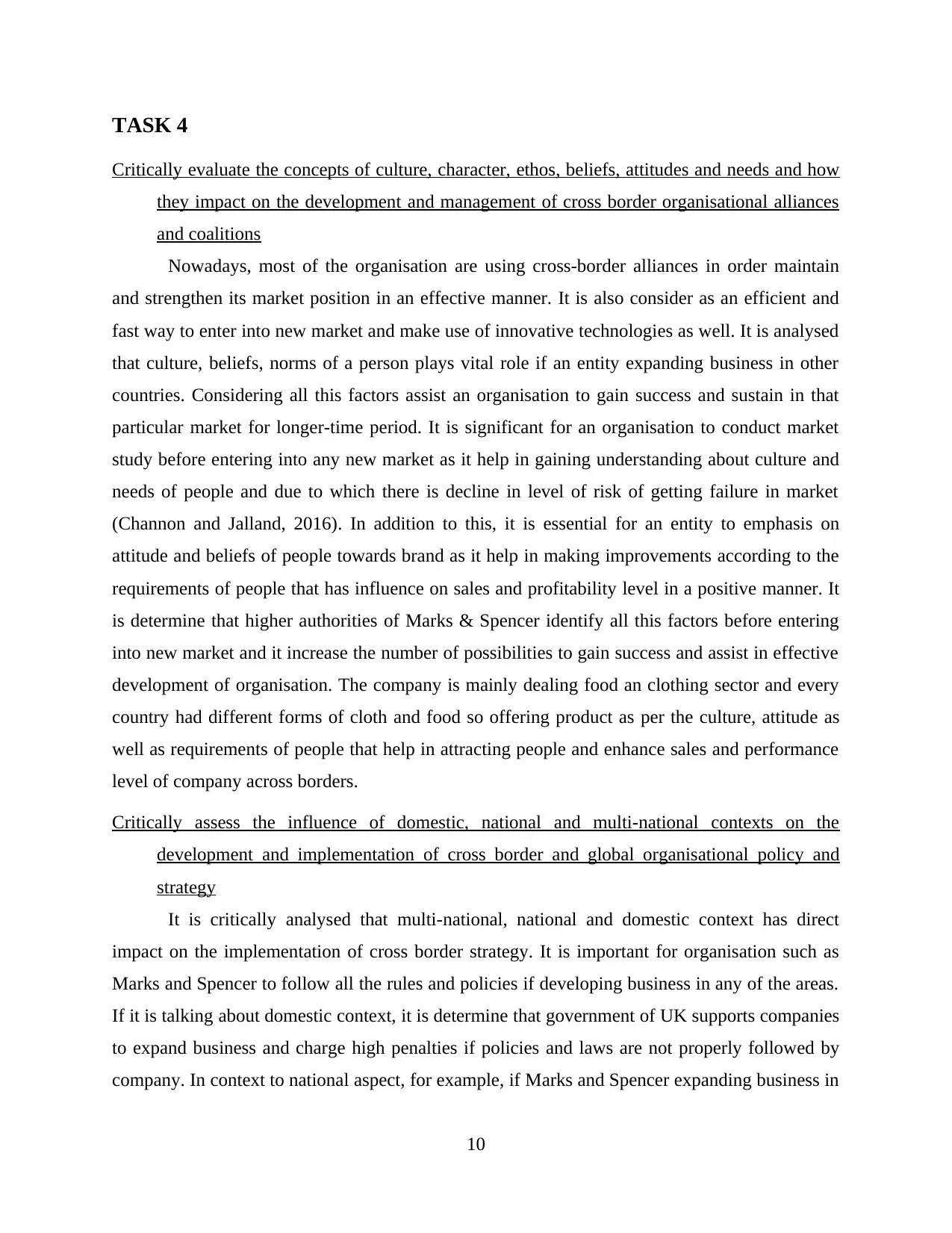
TASK 4
Critically evaluate the concepts of culture, character, ethos, beliefs, attitudes and needs and how
they impact on the development and management of cross border organisational alliances
and coalitions
Nowadays, most of the organisation are using cross-border alliances in order maintain
and strengthen its market position in an effective manner. It is also consider as an efficient and
fast way to enter into new market and make use of innovative technologies as well. It is analysed
that culture, beliefs, norms of a person plays vital role if an entity expanding business in other
countries. Considering all this factors assist an organisation to gain success and sustain in that
particular market for longer-time period. It is significant for an organisation to conduct market
study before entering into any new market as it help in gaining understanding about culture and
needs of people and due to which there is decline in level of risk of getting failure in market
(Channon and Jalland, 2016). In addition to this, it is essential for an entity to emphasis on
attitude and beliefs of people towards brand as it help in making improvements according to the
requirements of people that has influence on sales and profitability level in a positive manner. It
is determine that higher authorities of Marks & Spencer identify all this factors before entering
into new market and it increase the number of possibilities to gain success and assist in effective
development of organisation. The company is mainly dealing food an clothing sector and every
country had different forms of cloth and food so offering product as per the culture, attitude as
well as requirements of people that help in attracting people and enhance sales and performance
level of company across borders.
Critically assess the influence of domestic, national and multi-national contexts on the
development and implementation of cross border and global organisational policy and
strategy
It is critically analysed that multi-national, national and domestic context has direct
impact on the implementation of cross border strategy. It is important for organisation such as
Marks and Spencer to follow all the rules and policies if developing business in any of the areas.
If it is talking about domestic context, it is determine that government of UK supports companies
to expand business and charge high penalties if policies and laws are not properly followed by
company. In context to national aspect, for example, if Marks and Spencer expanding business in
10
Critically evaluate the concepts of culture, character, ethos, beliefs, attitudes and needs and how
they impact on the development and management of cross border organisational alliances
and coalitions
Nowadays, most of the organisation are using cross-border alliances in order maintain
and strengthen its market position in an effective manner. It is also consider as an efficient and
fast way to enter into new market and make use of innovative technologies as well. It is analysed
that culture, beliefs, norms of a person plays vital role if an entity expanding business in other
countries. Considering all this factors assist an organisation to gain success and sustain in that
particular market for longer-time period. It is significant for an organisation to conduct market
study before entering into any new market as it help in gaining understanding about culture and
needs of people and due to which there is decline in level of risk of getting failure in market
(Channon and Jalland, 2016). In addition to this, it is essential for an entity to emphasis on
attitude and beliefs of people towards brand as it help in making improvements according to the
requirements of people that has influence on sales and profitability level in a positive manner. It
is determine that higher authorities of Marks & Spencer identify all this factors before entering
into new market and it increase the number of possibilities to gain success and assist in effective
development of organisation. The company is mainly dealing food an clothing sector and every
country had different forms of cloth and food so offering product as per the culture, attitude as
well as requirements of people that help in attracting people and enhance sales and performance
level of company across borders.
Critically assess the influence of domestic, national and multi-national contexts on the
development and implementation of cross border and global organisational policy and
strategy
It is critically analysed that multi-national, national and domestic context has direct
impact on the implementation of cross border strategy. It is important for organisation such as
Marks and Spencer to follow all the rules and policies if developing business in any of the areas.
If it is talking about domestic context, it is determine that government of UK supports companies
to expand business and charge high penalties if policies and laws are not properly followed by
company. In context to national aspect, for example, if Marks and Spencer expanding business in
10
Paraphrase This Document
Need a fresh take? Get an instant paraphrase of this document with our AI Paraphraser
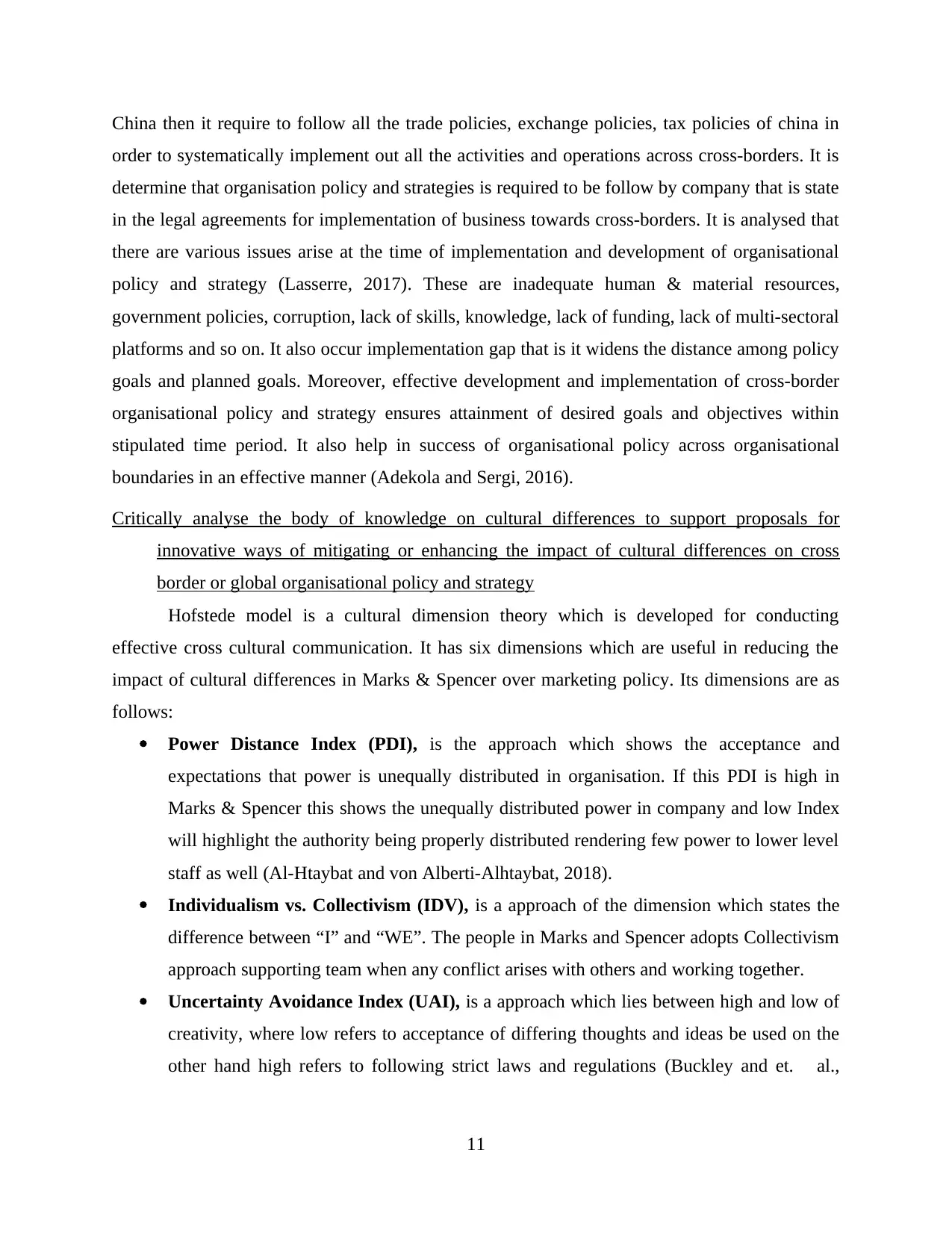
China then it require to follow all the trade policies, exchange policies, tax policies of china in
order to systematically implement out all the activities and operations across cross-borders. It is
determine that organisation policy and strategies is required to be follow by company that is state
in the legal agreements for implementation of business towards cross-borders. It is analysed that
there are various issues arise at the time of implementation and development of organisational
policy and strategy (Lasserre, 2017). These are inadequate human & material resources,
government policies, corruption, lack of skills, knowledge, lack of funding, lack of multi-sectoral
platforms and so on. It also occur implementation gap that is it widens the distance among policy
goals and planned goals. Moreover, effective development and implementation of cross-border
organisational policy and strategy ensures attainment of desired goals and objectives within
stipulated time period. It also help in success of organisational policy across organisational
boundaries in an effective manner (Adekola and Sergi, 2016).
Critically analyse the body of knowledge on cultural differences to support proposals for
innovative ways of mitigating or enhancing the impact of cultural differences on cross
border or global organisational policy and strategy
Hofstede model is a cultural dimension theory which is developed for conducting
effective cross cultural communication. It has six dimensions which are useful in reducing the
impact of cultural differences in Marks & Spencer over marketing policy. Its dimensions are as
follows:
Power Distance Index (PDI), is the approach which shows the acceptance and
expectations that power is unequally distributed in organisation. If this PDI is high in
Marks & Spencer this shows the unequally distributed power in company and low Index
will highlight the authority being properly distributed rendering few power to lower level
staff as well (Al-Htaybat and von Alberti-Alhtaybat, 2018).
Individualism vs. Collectivism (IDV), is a approach of the dimension which states the
difference between “I” and “WE”. The people in Marks and Spencer adopts Collectivism
approach supporting team when any conflict arises with others and working together.
Uncertainty Avoidance Index (UAI), is a approach which lies between high and low of
creativity, where low refers to acceptance of differing thoughts and ideas be used on the
other hand high refers to following strict laws and regulations (Buckley and et. al.,
11
order to systematically implement out all the activities and operations across cross-borders. It is
determine that organisation policy and strategies is required to be follow by company that is state
in the legal agreements for implementation of business towards cross-borders. It is analysed that
there are various issues arise at the time of implementation and development of organisational
policy and strategy (Lasserre, 2017). These are inadequate human & material resources,
government policies, corruption, lack of skills, knowledge, lack of funding, lack of multi-sectoral
platforms and so on. It also occur implementation gap that is it widens the distance among policy
goals and planned goals. Moreover, effective development and implementation of cross-border
organisational policy and strategy ensures attainment of desired goals and objectives within
stipulated time period. It also help in success of organisational policy across organisational
boundaries in an effective manner (Adekola and Sergi, 2016).
Critically analyse the body of knowledge on cultural differences to support proposals for
innovative ways of mitigating or enhancing the impact of cultural differences on cross
border or global organisational policy and strategy
Hofstede model is a cultural dimension theory which is developed for conducting
effective cross cultural communication. It has six dimensions which are useful in reducing the
impact of cultural differences in Marks & Spencer over marketing policy. Its dimensions are as
follows:
Power Distance Index (PDI), is the approach which shows the acceptance and
expectations that power is unequally distributed in organisation. If this PDI is high in
Marks & Spencer this shows the unequally distributed power in company and low Index
will highlight the authority being properly distributed rendering few power to lower level
staff as well (Al-Htaybat and von Alberti-Alhtaybat, 2018).
Individualism vs. Collectivism (IDV), is a approach of the dimension which states the
difference between “I” and “WE”. The people in Marks and Spencer adopts Collectivism
approach supporting team when any conflict arises with others and working together.
Uncertainty Avoidance Index (UAI), is a approach which lies between high and low of
creativity, where low refers to acceptance of differing thoughts and ideas be used on the
other hand high refers to following strict laws and regulations (Buckley and et. al.,
11

2016). Marks and Spencer scores low in it following new and unique path as the
workforce is diverse.
Masculinity vs. Femininity (MAS), represents the male and female perspectives in
culture of an organisation through which it is benefited. In a Marks and Spencer this
aspect is followed and no discrimination takes place in the company.
Long-term Orientation vs. Short-term Orientation (LTO), shows a high degree in
Marks and Spencer where firm adapts according to the new culture and surroundings.
Indulgence vs. Restraint (IND), this factor of culture shows indulgence where
employees have joy while working and be satisfied with their jobs in Marks and Spencer.
CONCLUSON
By considering the preceding information It is analysed that strategic planning is
important in terms of effectively running and operating an organisation which is helpful in
bringing effective change in organisation and also useful in operating business at the
international and global level. In terms of this, it also leads to include cultural based assumptions
regarding the customer needs, infrastructure, competitive weaknesses and so on that make it
more complex. In terms of this, various factors leads to influence the running of company and for
this, environmental analysis is important which is useful in eliminating and identifying other risk
factor.
12
workforce is diverse.
Masculinity vs. Femininity (MAS), represents the male and female perspectives in
culture of an organisation through which it is benefited. In a Marks and Spencer this
aspect is followed and no discrimination takes place in the company.
Long-term Orientation vs. Short-term Orientation (LTO), shows a high degree in
Marks and Spencer where firm adapts according to the new culture and surroundings.
Indulgence vs. Restraint (IND), this factor of culture shows indulgence where
employees have joy while working and be satisfied with their jobs in Marks and Spencer.
CONCLUSON
By considering the preceding information It is analysed that strategic planning is
important in terms of effectively running and operating an organisation which is helpful in
bringing effective change in organisation and also useful in operating business at the
international and global level. In terms of this, it also leads to include cultural based assumptions
regarding the customer needs, infrastructure, competitive weaknesses and so on that make it
more complex. In terms of this, various factors leads to influence the running of company and for
this, environmental analysis is important which is useful in eliminating and identifying other risk
factor.
12
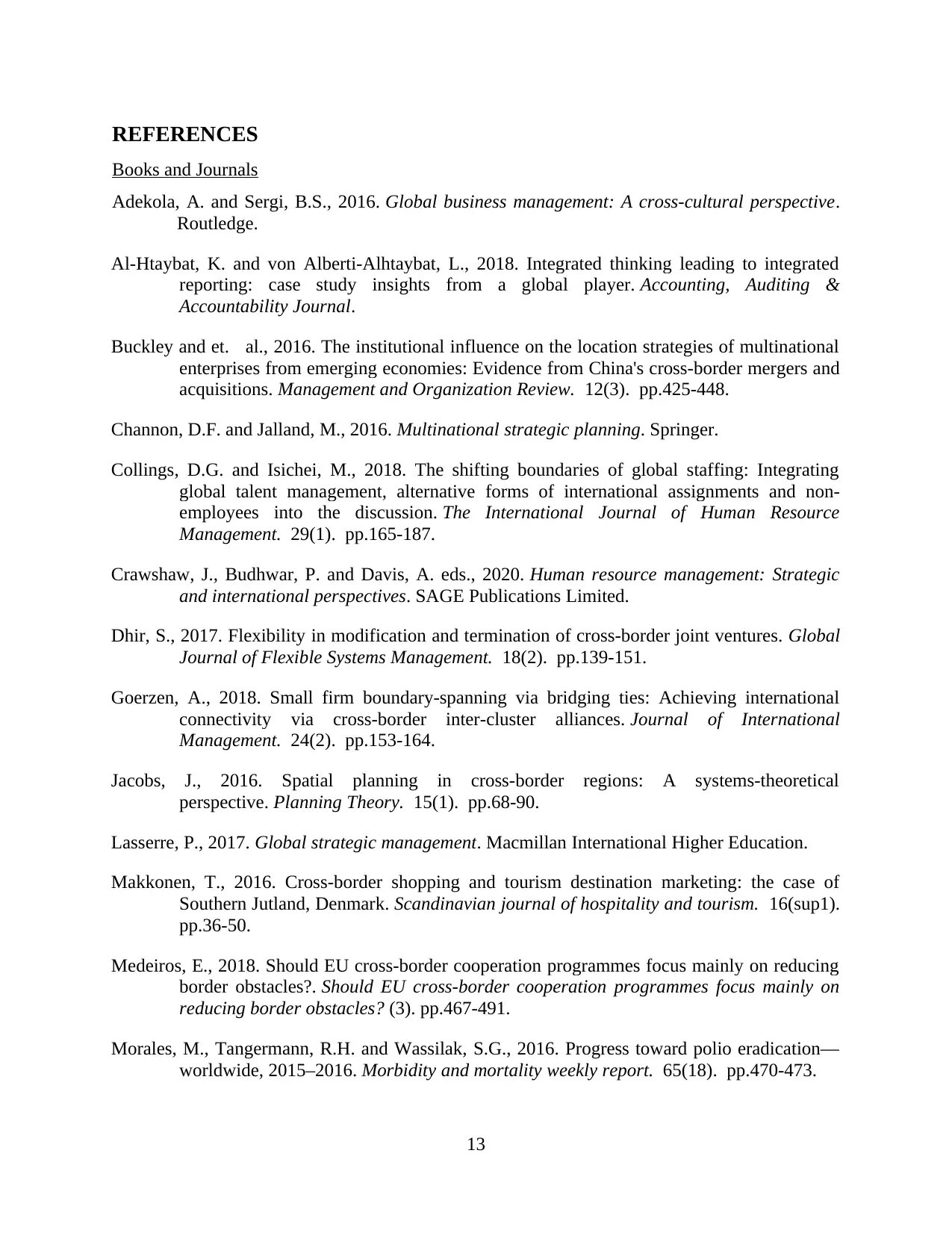
REFERENCES
Books and Journals
Adekola, A. and Sergi, B.S., 2016. Global business management: A cross-cultural perspective.
Routledge.
Al-Htaybat, K. and von Alberti-Alhtaybat, L., 2018. Integrated thinking leading to integrated
reporting: case study insights from a global player. Accounting, Auditing &
Accountability Journal.
Buckley and et. al., 2016. The institutional influence on the location strategies of multinational
enterprises from emerging economies: Evidence from China's cross-border mergers and
acquisitions. Management and Organization Review. 12(3). pp.425-448.
Channon, D.F. and Jalland, M., 2016. Multinational strategic planning. Springer.
Collings, D.G. and Isichei, M., 2018. The shifting boundaries of global staffing: Integrating
global talent management, alternative forms of international assignments and non-
employees into the discussion. The International Journal of Human Resource
Management. 29(1). pp.165-187.
Crawshaw, J., Budhwar, P. and Davis, A. eds., 2020. Human resource management: Strategic
and international perspectives. SAGE Publications Limited.
Dhir, S., 2017. Flexibility in modification and termination of cross-border joint ventures. Global
Journal of Flexible Systems Management. 18(2). pp.139-151.
Goerzen, A., 2018. Small firm boundary-spanning via bridging ties: Achieving international
connectivity via cross-border inter-cluster alliances. Journal of International
Management. 24(2). pp.153-164.
Jacobs, J., 2016. Spatial planning in cross-border regions: A systems-theoretical
perspective. Planning Theory. 15(1). pp.68-90.
Lasserre, P., 2017. Global strategic management. Macmillan International Higher Education.
Makkonen, T., 2016. Cross-border shopping and tourism destination marketing: the case of
Southern Jutland, Denmark. Scandinavian journal of hospitality and tourism. 16(sup1).
pp.36-50.
Medeiros, E., 2018. Should EU cross-border cooperation programmes focus mainly on reducing
border obstacles?. Should EU cross-border cooperation programmes focus mainly on
reducing border obstacles? (3). pp.467-491.
Morales, M., Tangermann, R.H. and Wassilak, S.G., 2016. Progress toward polio eradication—
worldwide, 2015–2016. Morbidity and mortality weekly report. 65(18). pp.470-473.
13
Books and Journals
Adekola, A. and Sergi, B.S., 2016. Global business management: A cross-cultural perspective.
Routledge.
Al-Htaybat, K. and von Alberti-Alhtaybat, L., 2018. Integrated thinking leading to integrated
reporting: case study insights from a global player. Accounting, Auditing &
Accountability Journal.
Buckley and et. al., 2016. The institutional influence on the location strategies of multinational
enterprises from emerging economies: Evidence from China's cross-border mergers and
acquisitions. Management and Organization Review. 12(3). pp.425-448.
Channon, D.F. and Jalland, M., 2016. Multinational strategic planning. Springer.
Collings, D.G. and Isichei, M., 2018. The shifting boundaries of global staffing: Integrating
global talent management, alternative forms of international assignments and non-
employees into the discussion. The International Journal of Human Resource
Management. 29(1). pp.165-187.
Crawshaw, J., Budhwar, P. and Davis, A. eds., 2020. Human resource management: Strategic
and international perspectives. SAGE Publications Limited.
Dhir, S., 2017. Flexibility in modification and termination of cross-border joint ventures. Global
Journal of Flexible Systems Management. 18(2). pp.139-151.
Goerzen, A., 2018. Small firm boundary-spanning via bridging ties: Achieving international
connectivity via cross-border inter-cluster alliances. Journal of International
Management. 24(2). pp.153-164.
Jacobs, J., 2016. Spatial planning in cross-border regions: A systems-theoretical
perspective. Planning Theory. 15(1). pp.68-90.
Lasserre, P., 2017. Global strategic management. Macmillan International Higher Education.
Makkonen, T., 2016. Cross-border shopping and tourism destination marketing: the case of
Southern Jutland, Denmark. Scandinavian journal of hospitality and tourism. 16(sup1).
pp.36-50.
Medeiros, E., 2018. Should EU cross-border cooperation programmes focus mainly on reducing
border obstacles?. Should EU cross-border cooperation programmes focus mainly on
reducing border obstacles? (3). pp.467-491.
Morales, M., Tangermann, R.H. and Wassilak, S.G., 2016. Progress toward polio eradication—
worldwide, 2015–2016. Morbidity and mortality weekly report. 65(18). pp.470-473.
13
Secure Best Marks with AI Grader
Need help grading? Try our AI Grader for instant feedback on your assignments.

Ramírez, R. and Selsky, J.W., 2016. Strategic planning in turbulent environments: A social
ecology approach to scenarios. Long Range Planning. 49(1). pp.90-102.
Reddy, K.S., Xie, E. and Huang, Y., 2016. Cross-border acquisitions by state-owned and private
enterprises: a perspective from emerging economies. Journal of Policy Modeling.
38(6). pp.1147-1170.
Reiche and et. al., 2016. Readings and cases in international human resource management.
Taylor & Francis.
Studzieniecki, T., 2016. The development of cross-border cooperation in an EU macroregion-a
case study of the Baltic Sea Region. Procedia Economics and Finance. 39. pp.235-
241.
Tallman, S., Luo, Y. and Buckley, P.J., 2018. Business models in global competition. Global
Strategy Journal. 8(4). pp.517-535.
Vendrell-Herrero and et. al., 2018. Uncovering the role of cross-border strategic alliances and
expertise decision centralization in enhancing product-service innovation in
MMNEs. International Business Review. 27(4). pp.814-825.
Xie, E., Reddy, K.S. and Liang, J., 2017. Country-specific determinants of cross-border mergers
and acquisitions: A comprehensive review and future research directions. Journal of
World Business. 52(2). pp.127-183.
Zheng, N and et. al., 2016. In search of strategic assets through cross-border merger and
acquisitions: Evidence from Chinese multinational enterprises in developed
economies. International Business Review. 25(1). pp.177-186.
14
ecology approach to scenarios. Long Range Planning. 49(1). pp.90-102.
Reddy, K.S., Xie, E. and Huang, Y., 2016. Cross-border acquisitions by state-owned and private
enterprises: a perspective from emerging economies. Journal of Policy Modeling.
38(6). pp.1147-1170.
Reiche and et. al., 2016. Readings and cases in international human resource management.
Taylor & Francis.
Studzieniecki, T., 2016. The development of cross-border cooperation in an EU macroregion-a
case study of the Baltic Sea Region. Procedia Economics and Finance. 39. pp.235-
241.
Tallman, S., Luo, Y. and Buckley, P.J., 2018. Business models in global competition. Global
Strategy Journal. 8(4). pp.517-535.
Vendrell-Herrero and et. al., 2018. Uncovering the role of cross-border strategic alliances and
expertise decision centralization in enhancing product-service innovation in
MMNEs. International Business Review. 27(4). pp.814-825.
Xie, E., Reddy, K.S. and Liang, J., 2017. Country-specific determinants of cross-border mergers
and acquisitions: A comprehensive review and future research directions. Journal of
World Business. 52(2). pp.127-183.
Zheng, N and et. al., 2016. In search of strategic assets through cross-border merger and
acquisitions: Evidence from Chinese multinational enterprises in developed
economies. International Business Review. 25(1). pp.177-186.
14
1 out of 17
Related Documents
Your All-in-One AI-Powered Toolkit for Academic Success.
+13062052269
info@desklib.com
Available 24*7 on WhatsApp / Email
![[object Object]](/_next/static/media/star-bottom.7253800d.svg)
Unlock your academic potential
© 2024 | Zucol Services PVT LTD | All rights reserved.




